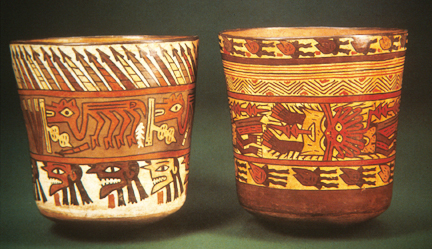
Nazca bowls, South Coastal Peru
Classic Period, circa 250 CE
ART 198 - HISTORY OF WORLD CERAMICS
| The Nazca culture dominated the south coastal regions of Peru during the Classic Period, and is named after the Nazca River valley. The Nazca are most famous as the creators of the giant earthworks, called geoglyphs. These immense drawings are carved into large open areas of desert and some images are over 12 miles in length, and can only be seen in their entirely from airplanes. Preceding the Nazca in this region was the Paracas culture, and in many ways, the ceramics of the Nazca show this influence. Whereas the Paracas used an incised line to separate colors, the Nazca style was to instead use a black line around each color. Just like in the Paracas ceramics, the Nazca did not use modeling. Instead areas of color are always filled in solid with no variation in tone. The pots were coil built and burnished and painted with a palette of up to eight slip colors, black, red, white, yellow, green, brown, violet, and cream. The imagery on Nazca vessels has not been completely understood, largely owing to the lack of a written language, but some imagery is seen often. On the right side, in the central frieze may be seen what has been called the 'mythical (or supernatural) being, a zoomorphic creatures with feline and human attributes. This creature is almost uniformly depicted as having a bifurcated tongue. Its meaning is otherwise not known. Textile patterns are common as well, and in the frieze above the 'mythical being' a chevron design, representing weaving is seen. On the vessel to the left are seen three friezes. At top is a row of what are called spears, an animal motif in the middle, and at the bottom, a row of gruesome trophy heads. | Nazca bowls, South Coastal Peru Classic Period, circa 250 CE |
|
|